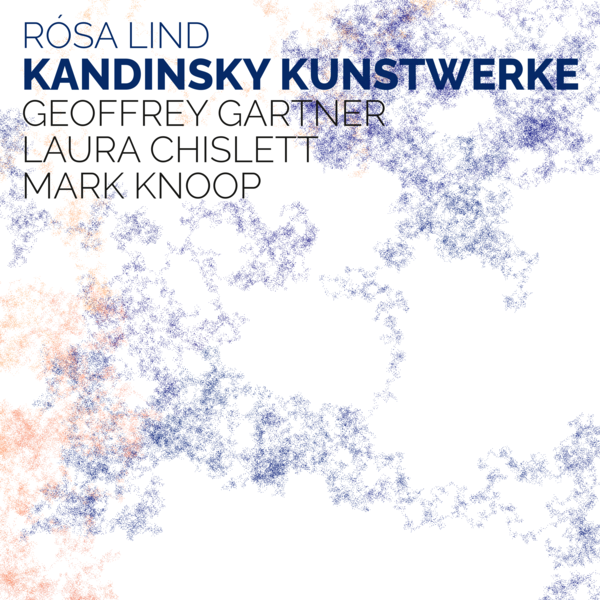
Rósa Lind
Kandinsky Kunstwerke
Geoffrey Gartner
Laura Chislett
Mark Knoop
atd17
This album features three works from a four-work cycle, each of which has as its starting point a canvas by Wassily Kandinsky and travels on to reflect and refract mythological and scientific views of astronomical phenomena. The common thread is one of perspective: Lind observes a similarity in ‘the way the eye approaches either Kandinsky’s painting or scans the vastness of the sky in search of stellar focal points of light in the black sea of night’.
Critical acclaim
A sense of wonder pervades this album – the culmination of decades of compositional inquiry – as Lind looks to astrology for spiritual fulfilment. In Lind’s idiom, I hear Kandinsky’s searching rhetoric echoing through time… Another world, indeed. Many worlds, really, within Lind’s interstellar, intertextual album.
Veteran Australian composer Rósa Lind spent more than 20 years composing the four cycles of her Kandinsky Kunstwerke, three of which are collected on this new album. The composer used a handful of paintings by the titular painter as a starting point for her writing, with each cycle including dense references to historical and cross-disciplinary associations. Yet even without the tangles of Lind’s non-musical inspirations at hand, the music’s mysterious narratives work.
Tracks
| 1 | Extrema: A Galilean Sarabande | 12:55 |
| 2 | Courbe dominante | 12:47 |
| Trente | ||
| 3 | Crux | 1:08 |
| 4 | Centaurus — le Corbeau — Telescopium | 3:30 |
| 5 | Argo Navis: Carina — Vela — Puppis | 3:33 |
| 6 | Canis Major — Eridanus | 2:19 |
| 7 | Lyra — Aquila — le Cygne | 3:54 |
| 8 | Serpens — Ophiuchus — Sagittarius — Scorpius | 5:05 |
| 9 | Pegasus — Hydra — Leo — Virgo | 5:29 |
| 10 | Boötes — Ursa Major — Orion — les Gémeaux — Pleiades | 6:09 |
| 11 | Perseus — Cetus — Andromeda — Cassiopeia | 4:42 |
| 12 | Polaris | 2:08 |
| TT | 63:39 |
This recording was supported by the Vaughan Williams Foundation.
Liner notes
Florence, Italy, 1610: the astronomer Galileo discovered three moons around the planet Jupiter. Sydney, Australia, 2001: composer Rósa Lind continues work on her cycle Kandinsky Kunstwerke with a new piece for amplified cello, Chinese gong and tape, Extrema: A Galilean Sarabande — Timeplay. Further travel through time and space is involved in its composition: extrema, the mathematical term denoting the turning points of a curve, is a musical refraction of the Sarabande from J.S. Bach’s Cello Suite no. 5. It runs continuously but is divided into ‘time-space moments’ named after the four Jovian moons, Callisto, Ganymede, Europa, and Io (the planet Jupiter itself is represented by the Chinese wind gong). Finally comes ‘Osservazioni (1610)’, the score of which is inscribed with Galileo’s Latin observations. Combining extended techniques and a tape of radio signals from Jupiter, to be played at frequencies so low they are felt more than heard, Extrema draws the cello inexorably towards the solar system’s largest anticyclonic storm, Jupiter’s ‘Great Red Spot’. Or, perhaps, towards a tiny painting Kandinsky gave to his wife in 1925, Small Dream in Red.
The importance of Small Dream in Red for Kandinsky was apparent in it being the only colour plate in his 1926 treatise Point and Line to Plane. There, Kandinsky spends some time discussing curves, which feature in many of his artworks, including Courbe dominante (Dominant Curve, 1936). Rósa Lind describes her piece by the same name as ‘an abstract sequence of dance movements for flutes and other sound sources, from a planetary origin (0, 0, 0) through the resonant arcs of Saturn’s rings to multiple imagined vanishing points’. In 1659, Dutch scientist Christiaan Huygens created lenses that allowed him to detect the true curvature of Saturn’s rings. Time leaps again, to the 1911 premiere of Arnold Schoenberg’s Second String Quartet, in which a setting for soprano of Stefan George’s ‘Entrückung’ includes the line “I am dissolved in swirling sound” (“Ich löse mich in Tönen, kreisend”). Afterwards Kandinsky wrote to Schoenberg that he had realised what he had been longing for in music and his paintings: ‘the independent progress of individual voices through their own destinies’. In Rósa Lind’s Courbe dominante, processed fragments from ‘Entrückung’ merge with the sound spectra of kilometric radiation emitted from Saturn. All dissolves in swirling sound.
Kandinsky’s monochrome grid Trente (1937) provides the title and structure of Rósa Lind’s fourth piece in the Kunstwerke cycle. Alternating black and white fields are explored as they relate to the keyboard, with metaphorical extremes of light and dark, positive and negative, reflected in the thirty short movements, the order of which (except the first and last) is determined by the performer. Rósa Lind compares this process to ‘the way the eye approaches either Kandinsky’s painting or scans the vastness of the sky in search of stellar focal points of light in the black sea of night’. The score of Trente is annotated extensively with textual allusions and quotations and performance instructions. Alongside constellations, Greek myth and epic poems are references to film (Gilles Deleuze and Luis Buñuel) and to female poets from across the centuries (Catherine Pozzi, Gaspara Stampa, Louise Labé, Muriel Rukeyser, Adrienne Rich): gods and goddesses of history’s skies.
Laura Tunbridge